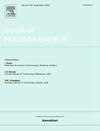Accuracy analysis of different numerical methods on thermal stratification prediction of liquid metal
IF 2.3
3区 工程技术
Q1 NUCLEAR SCIENCE & TECHNOLOGY
引用次数: 0
Abstract
The study of thermal stratification is of significant importance for the safety analysis of pool-type sodium fast reactors, and numerical simulation is an essential tool for investigating thermal stratification phenomena. This work evaluates the effectiveness of a couple of CFD solvers in predicting thermal stratification. It compares the impact of different discretization schemes on solution accuracy and analyzes the reasons for observed discrepancies. Several discretization schemes effectively capture thermal stratification, with the high-resolution scheme showing an average error of 4.2 % and a maximum temperature error of 7.7 K, while the second-order upwind scheme shows an average error of 2.59 % and a maximum temperature error of 6.9 K. Additionally, this study investigates the impact of different order difference schemes on the simulation results of thermal stratification. For conditions where the Richardson number (Ri) is greater than 0.82, the simulation results of the first-order upwind scheme are similar to those of the second-order upwind scheme.
不同数值方法对液态金属热分层预测的精度分析
热分层现象的研究对池式钠快堆的安全性分析具有重要意义,而数值模拟是研究热分层现象的重要工具。本工作评估了几个CFD求解器在预测热分层中的有效性。比较了不同离散化方案对求解精度的影响,分析了观测到差异的原因。几种离散化方案有效地捕获了热分层,其中高分辨率方案的平均误差为4.2%,最大温度误差为7.7 K,而二阶迎风方案的平均误差为2.59%,最大温度误差为6.9 K。此外,本文还研究了不同阶差格式对热分层模拟结果的影响。在理查德森数(Ri)大于0.82的情况下,一阶逆风方案的模拟结果与二阶逆风方案的模拟结果相似。
本文章由计算机程序翻译,如有差异,请以英文原文为准。
求助全文
约1分钟内获得全文
求助全文
来源期刊

Annals of Nuclear Energy
工程技术-核科学技术
CiteScore
4.30
自引率
21.10%
发文量
632
审稿时长
7.3 months
期刊介绍:
Annals of Nuclear Energy provides an international medium for the communication of original research, ideas and developments in all areas of the field of nuclear energy science and technology. Its scope embraces nuclear fuel reserves, fuel cycles and cost, materials, processing, system and component technology (fission only), design and optimization, direct conversion of nuclear energy sources, environmental control, reactor physics, heat transfer and fluid dynamics, structural analysis, fuel management, future developments, nuclear fuel and safety, nuclear aerosol, neutron physics, computer technology (both software and hardware), risk assessment, radioactive waste disposal and reactor thermal hydraulics. Papers submitted to Annals need to demonstrate a clear link to nuclear power generation/nuclear engineering. Papers which deal with pure nuclear physics, pure health physics, imaging, or attenuation and shielding properties of concretes and various geological materials are not within the scope of the journal. Also, papers that deal with policy or economics are not within the scope of the journal.
 求助内容:
求助内容: 应助结果提醒方式:
应助结果提醒方式:


